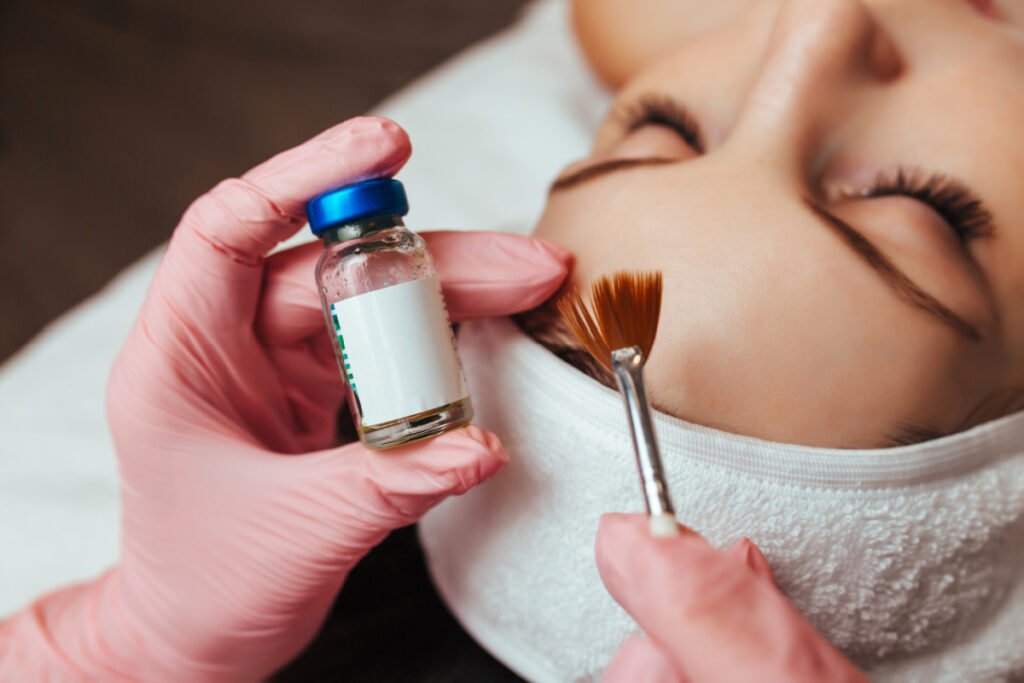
At our Fort Worth medical spa, educating and empowering our patients about their skin conditions is just as important as offering the safest, most effective solutions to treat them. Asphyxiated skin is an often overlooked but significant skin concern: Here, we break down everything you need to know about asphyxiated skin, from what it is to how you can treat it with chemical peels and facials.
What is asphyxiated skin?
Asphyxiated skin refers to a condition where the skin looks and feels dry on the surface yet is oily beneath. It is caused by a lack of oxygen and nutrients from environmental factors such as pollution and smoking, but more often from clogged pores that prevent your skin from breathing, shedding dead skin cells, and regulating oil production.
Not fully removing your makeup or skipping exfoliating products in your weekly skincare routine allows product residue, dead skin cells, sebum, and other impurities to clog and “suffocate” your skin, leading to a dull complexion and asphyxiated skin. The term may sound alarming, but it is a fairly common condition.
Asphyxiated skin is often misidentified as “combination skin,” where the skin is both dry and oily.
How chemical peels help treat asphyxiated skin
Chemical peels remove the outer layers of dead skin to help unclog pores and promote cell regeneration. This process addresses surface dryness and helps regulate oil production underneath for a balanced, clearer complexion. Chemical peels also minimize fine lines, sun damage, and other pigmentation issues, making them a versatile treatment option to treat several skin concerns at once.
At Kalos Medical Spa, we offer 6 different VI Peel formulas to customize your peel for superior results.


Are there other effective treatments?
Absolutely! Chemical peels are highly effective in breathing new life into asphyxiated skin, however, we understand that one treatment does not fit all. Here are a few other options that may help manage asphyxiated skin:
- Hydrafacial MD®: This multi-step facial exfoliates the skin and decongests pores while infusing the skin with physician-only skin boosters and hydrating serums. Hydrafacials exfoliate the skin more gently than chemical peels; however, they are effective in enhancing skin texture and health. Our Deluxe and Platinum Hydrafacial MD treatments include LED light therapy, which is antimicrobial and can help reduce the oiliness associated with asphyxiated skin.
- Medical-grade skincare: Incorporating physician-only skincare products suited to your skin type and concerns also makes a significant difference in your skin’s health and appearance. Professional products such as retinols, serums, and exfoliants contain higher concentrations of active ingredients to increase new cell growth and help slough off dead cells and debris before they can clog your pores. Our skincare specialists curate skincare regimens to target the root causes of your skin concerns without stripping the skin and disrupting your skin’s natural barrier.
Ready to revitalize your skin?“Amazing place with amazing people! All the providers are so kind and knowledgeable. The front desk ladies are very pleasant to talk to. I highly recommend coming in and treating yourself to an amazing facial, Botox or other rejuvenating treatment!!”
—5-star Google review
If you think you may have asphyxiated skin, or if you want to rejuvenate and balance your complexion, we are here to help. Fort Worth plastic surgeon Dr. Emily Kirby works closely with our medical spa professionals to identify your skin woes and recommend treatments and products that bring the skin back to life. To schedule your appointment with one of our Physician Assistants or licensed aestheticians, please call Kalos Medical Spa, located within Kirby Plastic Surgery at (817) 292-4200 or submit our patient form at the bottom of this page.
References »
Freedman BM. Hydradermabrasion: an innovative modality for nonablative facial rejuvenation. Journal of Cosmetic Dermatology. 2008 Dec;7(4):275-80. doi: 10.1111/j.1473-2165.2008.00406.x.
Rendon MI, Berson DS, Cohen JL, Roberts WE, Starker I, Wang B. Evidence and considerations in the application of chemical peels in skin disorders and aesthetic resurfacing. Journal of Clinic and Aesthetic Dermatology. 2010 Jul;3(7):32-43.
te Hennepe M. ‘To preserve the skin in health’: drainage, bodily control and the visual definition of healthy skin 1835-1900. Medical History. 2014 Jul;58(3):397-421. doi: 10.1017/mdh.2014.30.


